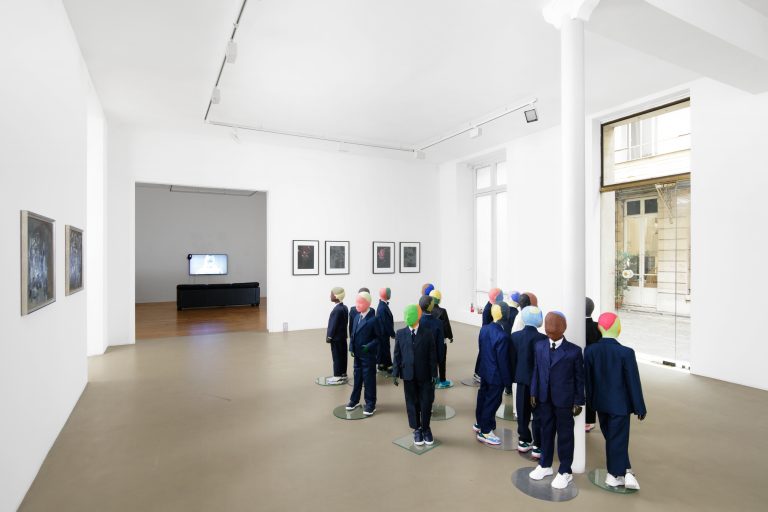Columpio
1999 - Photography (Photography)
40,4 x 51 cm
Gabriel Orozco
Gabriel Orozco could be described as a traveler-artist, without a fixed studio. He works following contexts and produces work that flows. “Special Service” (1997) is a collage on a plane ticket, and indicates nomadism, between territories. The artist, who is the son of muralist Mario Orozco Riviera, questions the boundaries of his artistic identity in Mexico. In “Crazy tourist” (1991), Orozco creates a situation with oranges in the Brazilian market tables in a desert. The artist uses objects or “poor” situations, found in the everyday landscape, natural or urban. By their division, their juxtaposition, or collage, inventing semantic or sensitive scenarios, always surprising, sometimes humorous and sometimes lyrical … The sculptural practice of the artist, inseparable from his drawings, photographs, or films, invents relationships of space, and disrupts our perception of objects. Such is the case of “Yielding Stone” (1992), a photo of a plasticine ball, the weight of the artist, rolled through the streets of New York. Gabriel Orozco was born in 1962 in Jalapa, Mexico. He lives and works in New York, Mexico, and Paris.
Colors:
Related works sharing similar palette

© » KADIST
Chemi Rosado-Seijo
2016Map of the Universe from El Cerro continues Chemi Rosado-Seijo’s long-term engagement with the community of El Cerro , a rural, working-class community living in the mountains of Naranjito, Puerto Rico...

© » TWOCOATSOFPAINT
Afire: Christian Petzold’s combustible feast – Two Coats of Paint Afire (directed by Christian Petzold), 2023, Leon on the beach (Thomas Schubert) , courtesy of Janus Films Contributed by Jonathan Stevenson / Instability hovers on several fronts – environmental, political, economic – and German filmmaker Christian Petzold manifests his concern about it with remarkable astuteness...

© » KADIST
Naufus Ramírez-Figueroa
2018In Guardian 2 Naufus Ramírez Figueroa explores the historical memory and political reality of the ruins of Kawinal, an archeological site of postclassic Mayan culture that was flooded in order to construct the hydroelectric dam of Chixoy in 1975 in a supposed effort to bring electricity to the country...

© » KADIST
María Buenaventura
2011The Territory is not for sale is a process of reflection and research with people, thinkers and community leaders from Usme, a rural part of Bogotá on the tenuous verge of becoming urban...

© » KADIST
Javier Castro
2012In the film La Edad de Oro (The Golden Age) Javier Castro asks several children to describe what they want to be when they grow up and what their best career option is in Cuba...

© » ART & OBJECT
Art Institute of Chicago Workers Ratify First Contract | Art & Object Skip to main content Subscribe to our free e-letter! Webform Your Email Address Role Art Collector/Enthusiast Artist Art World Professional Academic Country USA Afghanistan Albania Algeria American Samoa Andorra Angola Anguilla Antarctica Antigua & Barbuda Argentina Armenia Aruba Ascension Island Australia Austria Azerbaijan Bahamas Bahrain Bangladesh Barbados Belarus Belgium Belize Benin Bermuda Bhutan Bolivia Bosnia & Herzegovina Botswana Bouvet Island Brazil British Indian Ocean Territory British Virgin Islands Brunei Bulgaria Burkina Faso Burundi Cambodia Cameroon Canada Canary Islands Cape Verde Caribbean Netherlands Cayman Islands Central African Republic Ceuta & Melilla Chad Chile China Christmas Island Clipperton Island Cocos (Keeling) Islands Colombia Comoros Congo - Brazzaville Congo - Kinshasa Cook Islands Costa Rica Croatia Cuba Curaçao Cyprus Czechia Côte d’Ivoire Denmark Diego Garcia Djibouti Dominica Dominican Republic Ecuador Egypt El Salvador Equatorial Guinea Eritrea Estonia Eswatini Ethiopia Falkland Islands Faroe Islands Fiji Finland France French Guiana French Polynesia French Southern Territories Gabon Gambia Georgia Germany Ghana Gibraltar Greece Greenland Grenada Guadeloupe Guam Guatemala Guernsey Guinea Guinea-Bissau Guyana Haiti Heard & McDonald Islands Honduras Hong Kong SAR China Hungary Iceland India Indonesia Iran Iraq Ireland Isle of Man Israel Italy Jamaica Japan Jersey Jordan Kazakhstan Kenya Kiribati Kosovo Kuwait Kyrgyzstan Laos Latvia Lebanon Lesotho Liberia Libya Liechtenstein Lithuania Luxembourg Macao SAR China Madagascar Malawi Malaysia Maldives Mali Malta Marshall Islands Martinique Mauritania Mauritius Mayotte Mexico Micronesia Moldova Monaco Mongolia Montenegro Montserrat Morocco Mozambique Myanmar (Burma) Namibia Nauru Nepal Netherlands Netherlands Antilles New Caledonia New Zealand Nicaragua Niger Nigeria Niue Norfolk Island Northern Mariana Islands North Korea North Macedonia Norway Oman Outlying Oceania Pakistan Palau Palestinian Territories Panama Papua New Guinea Paraguay Peru Philippines Pitcairn Islands Poland Portugal Puerto Rico Qatar Romania Russia Rwanda Réunion Samoa San Marino Saudi Arabia Senegal Serbia Seychelles Sierra Leone Singapore Sint Maarten Slovakia Slovenia Solomon Islands Somalia South Africa South Georgia & South Sandwich Islands South Korea South Sudan Spain Sri Lanka St...

© » ARTS EQUATOR
Podcast 84: Traditional Arts: Dikir Barat, Kavadi Attam and Nanyin | ArtsEquator Thinking and Talking about Arts and Culture in Southeast Asia ArtsEquator Viewpoints December 8, 2020 ArtsEquator speaks to Lyn Lee, Nirmala Seshadri and Soultari Amin Farid about Nanyin, Kavadi Attam and Dikir Barat and the study and practice of traditional arts in Singapore...

© » KADIST
Luka Yuanyuan Yang
2019Composed of three photographic panels, Three Times at Yamato Hotel by Luka Yuanyuan Yang is a part of the artist’s ongoing project Dalian Mirage , a seven act play in a theatre staged as the city of Dalian...

© » KADIST
Xiaoyun Chen
2012The lengthy titles in Chen Xiaoyun’s work often appear as colophons to his photographs that invite the viewer to a process of self realization through contemplating the distance between word and image...

© » ARTS EQUATOR
Criticism and Tears: The Emotional is Political in the Marcos State | ArtsEquator Skip to content When a film taps on emotions to distort historical facts, criticism that uses a rational, adversarial voice, above the work and the audiences who enjoy it may fail to dislodge the emotive power of the work’s narrative...










